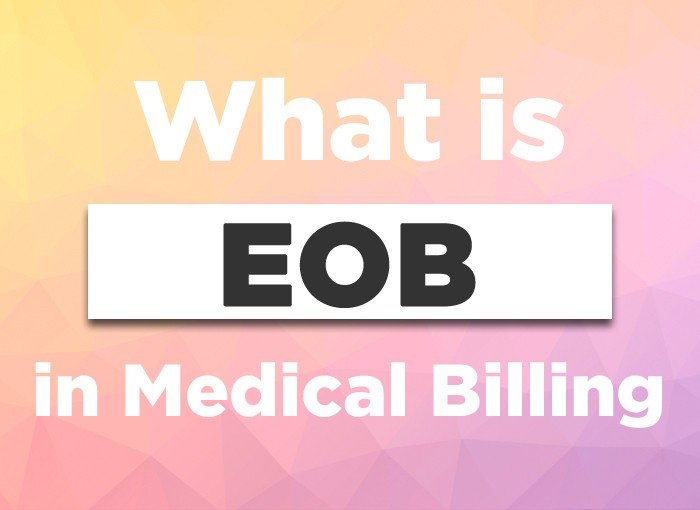What does EOB stand for in Medical Billing
Patients are provided with an EOB statement along with the final bill or patient bill. This statement is sometimes confused with the final bill itself due to the remaining balance/patient balance mentioned. However, this statement is not a bill but an explanation of benefits as provided by the hospital and insurance payer to the patient.
Definition of EOB
Medical billing professionals abbreviate EOB as Explanation of Benefits, which displays the medical coverage details provided by insurance payers to patients. The statement provides the patient with an update that includes all information about submitted claims, insurance payments, and remaining patient responsibility.
Purpose of EOB Statement
The standard EOB statement displays the service date along with the procedure name and code while showing claim amounts and discounts total coverage patient liability policy deductibles and co-payment amounts.
An explanation of claim processing appears in this document to inform patients about their insurance benefit status. The EOB statement verifies that insurance coverage exists for patients’ medical benefits according to their healthcare insurance plan. A health care insurance plan contains distinct medical advantages which determine coverage for various medical procedures. The insurance payer needs to provide clear explanations of covered benefits because confusion must be avoided.
Types of EOB Statements
There are several variations of EOB statements that patients might encounter in their medical billing process:
- Standard EOB: The most common type, which provides a detailed breakdown of medical services, charges, and insurance coverage for a specific medical claim or healthcare service.
- Consolidated EOB: A comprehensive statement that combines multiple medical services or claims from a single healthcare provider or across different providers within a specific time frame.
- Electronic EOB (e-EOB): A digital version of the traditional paper statement, typically accessible through online patient portals or insurance company websites. These electronic statements offer increased convenience and immediate access to billing information.
Role of EOB in Medical Billing
The healthcare billing process is complex for patients with insurance. Every day, hospitals see thousands of insured patients, so it’s crucial to keep tabs on each patient’s covered benefits based on their chosen insurance plan. This helps avoid any issues that could hurt the finances of both the hospital and the insurance company. Here’s why EOB plays a key role in medical billing:
- Assured Insurance Benefits: With all the benefits mentioned on the EOB statement you may verify the benefit(s) that were not paid by the insurance payer as per the health care insurance plan. This also helps in marinating transparency in the claim submission process.
- No More Overpaying/Underpaying Medical Bills: Mentioning the explanation of benefits helps in preventing up-coding/under-coding fraud by generating the correct bill for the procedures that the patient has received. In case of any discrepancy, in the final bill and EOB, the patient can question both the hospital and insurance payer. In other words, the patient has to pay the actual amount that he/she owes to the hospital, nothing more nothing less.
- Revenue Cycle Management: EOB also works in favor of the healthcare industry by maintaining the revenue cycle. Once the patient has received the EOB along with the final then he/she is required to cross-check the covered benefits and report the discrepancy. In the case of no discrepancy, the patient is obligated to pay the due amount. This is vital in preventing any financial loss by ensuring that the healthcare provider gets paid for his/her medical services without any failure.
In a manner, the EOB statement in medical billing is very also important in getting full reimbursement and preventing insurance denial or fraud.
Complex Components of an EOB Statement
While the basic EOB provides essential information, a detailed statement typically includes more nuanced components:
- Pricing Breakdown: It reveals the total charge and displays the allowed amount and the negotiated rates that healthcare providers established with insurance companies.
- Benefit Calculation: The method that determines specific benefits through the patient’s insurance plan includes an explanation of copayments coinsurance and deductible requirements.
- Provider Network Information: Indication of whether the healthcare provider is in-network or out-of-network, which significantly impacts patient costs.
Common Misconceptions About EOBs
Several misconceptions surround EOB statements that patients should be aware of:
- Not a Bill: As mentioned earlier, an EOB is not a bill but a detailed explanation of how a medical claim was processed.
- Complexity of Insurance Codes: The numerous codes and technical terminology can be overwhelming for patients, leading to confusion about actual medical charges.
- Timing of EOB Delivery: Medical service providers receive EOBs from insurance companies after their services have been processed thus delivery can take several weeks from the treatment date.
Legal and Regulatory Aspects of EOBs
The generation and management of EOBs are governed by several legal and regulatory frameworks:
- HIPAA Compliance: Multiple legal and regulatory frameworks control the generation process and management. EOBs need to follow all requirements from the Health Insurance Portability and Accountability Act (HIPAA) which ensures both patient information privacy as well as secure information management.
- Transparency Requirements: The law demands healthcare organizations to deliver EOB statements which must present information in easy-to-understand ways for patient protection and healthcare billing transparency purposes.
Navigating Complex Medical Billing
Resources for Patient Education
- Government healthcare websites
- Insurance company patient support centers
- Medical billing advocacy groups
- Online educational platforms
Dispute Resolution Strategies
- Formal appeal processes
- Insurance company complaint mechanisms
- State Insurance Commission interventions
- Third-party medical billing advocates
Conclusion
Medical billing relies heavily on the Explanation of Benefits document for delivering essential patient information. Patients who understand EOBs’ purpose and their components and other details can successfully manage healthcare costs together with correct billing and better healthcare choices.
EOBs exist as a transparent system which makes the complex medical billing procedure more understandable to patients regarding insurance claims and personal financial obligations.



